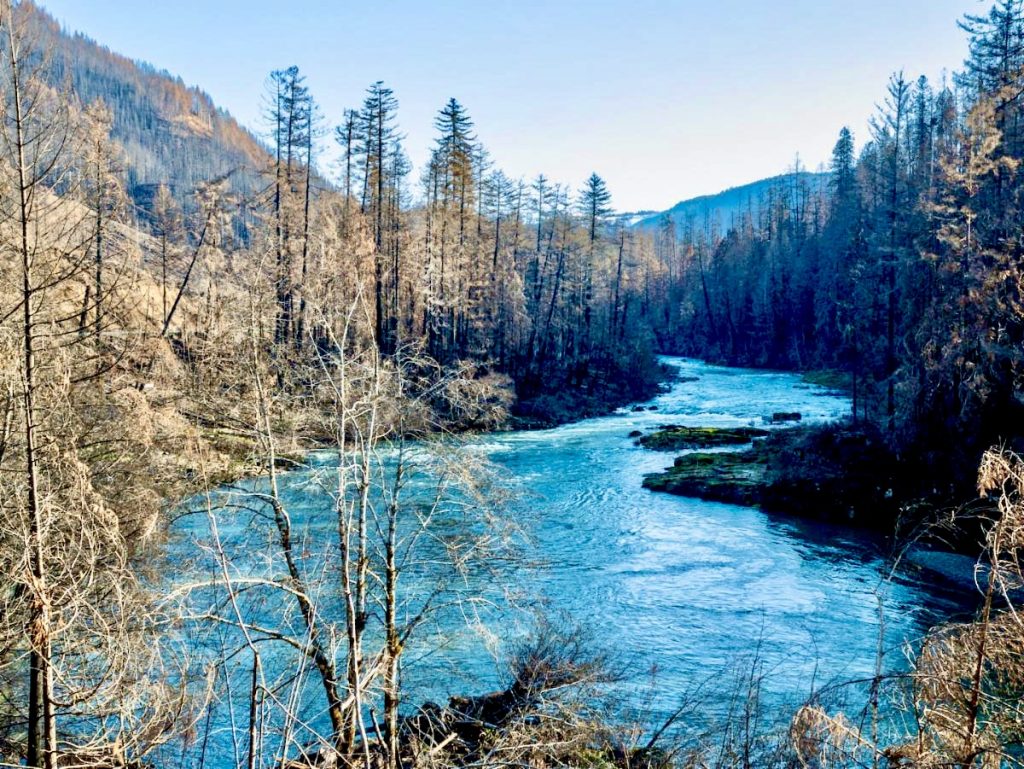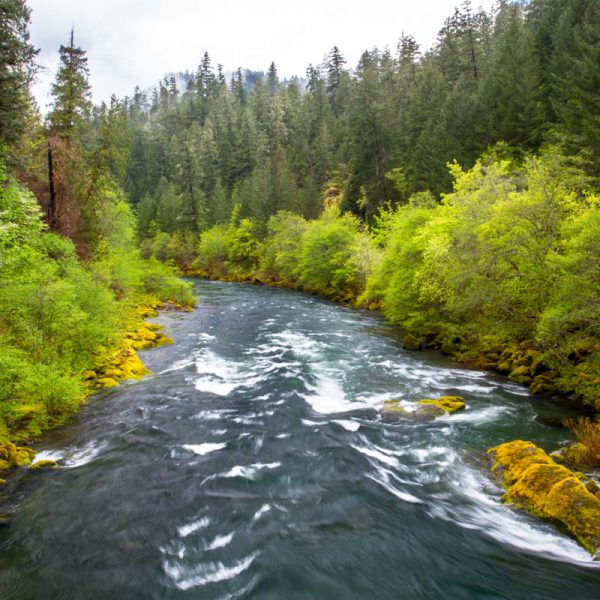
Article by Jeff Dose
Restoring abundant runs of wild Pacific salmon and anadromous trout, that is, fish spawned in natural habitat from wild parents, to the rivers and streams of the Pacific Northwest has risen to the highest levels in the public’s consciousness. As a consequence, there is attention from the regions’ and nations’ top elected officials and a large expenditure of public and private funds in an effort to prevent extinction and restore some measure of historical abundance. This attention is certainly true here, in the Umpqua River basin, where our fish runs support a multitude of recreational and commercial enterprises and where there is concern for some greatly diminished populations.
The North Umpqua River has one of the most diverse populations of wild salmon and searun trout in coastal Oregon. There exist six different races representing four species. These are spring Chinook salmon, fall Chinook salmon, coho salmon, winter steelhead, summer steelhead, and searun cutthroat trout. In addition to the wild populations, there are artificially propagated populations from hatcheries, principally Rock Creek hatchery, where large numbers of juvenile spring Chinook salmon and summer steelhead are released into the North Umpqua. The hatchery also produced coho salmon and winter steelhead to augment populations elsewhere in the Umpqua basin.
The historically large and intense wildfires that started in early September of this year throughout western Oregon caused extraordinary losses to property and infrastructure. Several fish hatcheries were impacted, Rock Creek hatchery along the North Umpqua River, was nearly completely destroyed by the Archie Creek Fire. Reconstruction of this facility has been estimated to cost as much as $15 million. Even before the Archie Creek Fire, Rock Creek was a compromised watershed with poor water quality. High summer water temperatures necessitated construction and operation of a pumping station to draw water from the North Umpqua to allow survival of the adult and juvenile fish that were being held during the summer. The impacts from the highly intense fire, as well as suppression actions and salvage logging, will further degrade the Rock Creek watershed for decades. Additionally, anticipated impacts from climate change will likely further retard or prevent meaningful watershed recovery. As I describe below, there are some considerations that should be seriously considered as to whether that level of public expenditure is prudent.
Pacific salmon, broadly defined to include sea-run trout, are a truly remarkable and successful group of animals. During this time period, they have endured numerous global-scale climate changes – upheavals that caused the extinction of an untold numbers of other species – yet they persisted, albeit not always in the same locales. Through evolutionary processes such as natural selection, salmon have been able to persist, and even thrive, by developing some rather unique and impressive characteristics and abilities which enhance their genetic diversity, including:
- the ability to “navigate” and migrate enormous distances;
- a very fine-tuned “homing” ability that allows them to return to their natal streams, while at the same time having sufficient straying capability to colonize new or previously lost habitats;
- a life-history which results in the bulk of the population being at sea during the “catastrophic” natural disturbances (e.g., floods, wildfire, drought, etc.) which occur periodically within their freshwater habitat;
- the ability to dramatically change their kidney function so as to be able to move between fresh and salt water, which allows them to utilize the relatively rich marine environment for growth and the relatively safe freshwater environment for reproduction and initial rearing; and;
- the ability to evolve quickly to different environments by adopting life-history strategies, such as migration timing or body size, to a wide variety of different, localized freshwater environments – ranging from intermittent streams in southern California to alpine lakes near the continental divide in Idaho to frequently frozen rivers above the Arctic Circle in Alaska and Canada.
Managing salmon resources involves preventing overharvest, protecting and restoring habitat, managing hydro and other dams, and augmentation of wild populations with hatchery production. While counter-intuitive, large-scale hatchery production does not usually produce more fish and can seriously reduce fitness of wild populations. Most current hatchery practices, such as supplementing wild populations with hatchery-bred fish produced from artificial selection, rather than natural selection, are antithetical to the goal. Additionally, hatchery production requires a large investment of funds that might be better spent on habitat acquisition and restoration, alternative energy sources, law enforcement or better research, monitoring and evaluation. It is not uncommon for the return of one hatchery salmon to cost hundreds or thousands of dollars. The majority of which is paid by taxpayers and ratepayers, not from the sale of licenses and tags.
Among other effects, genetic changes are contributing to the problem of salmon declines. Most recent legitimate, peer reviewed research has shown significant reductions in wild salmon and steelhead production when hatchery fish are spawning with wild fish, even at fairly low levels (~10-15%) of hatchery fish.
In addition to genetic effects from interbreeding, impacts to wild salmon begin as soon as the hatchery fish are released into the rivers and streams. These potentially include disease transmission, competition, direct predation, altered migratory behavior, and altered predator survival and behavior. In addition to these direct effects, the release of 10’s of thousands of hatchery reared fish (and their subsequent return) makes it nearly impossible to assess accurately the status of wild stocks. This is further exacerbated during periods of high ocean productivity when hatchery fish survive (and return to spawn) at much higher rates than at other times. The offspring from these pairings are unmarked and are essentially indistinguishable (without genetic analysis) from true wild stocks. They are then usually counted, inappropriately, as wild. Despite the large body of scientific information that portrays the damage done, there has been little real change in the current hatchery/harvest paradigm. Similarly, there has been very little change in land and water uses that affect salmon habitat.
As to habitat “restoration,” most of what has been done to date is the uncoordinated treatment of some of the more obvious symptoms, while totally ignoring the causes – like widespread clearcutting and road building in forest watersheds, unrestricted livestock grazing, diversions of large amounts of water from stream channels for irrigation and domestic use, urban and industrial development on and adjacent to floodplains, and retention of damaging, outdated dams. Successful, widespread restoration of wild salmon stocks will require a significant paradigm shift from current approaches. Many researchers have concluded that for restoration programs to succeed, there must be a shift away from simplistic technofixes – such as hatcheries for low fish numbers or log structures for poor watershed conditions – to ecologically-based restoration of watershed processes.
I’ll conclude with a quote from the book Salmon Without Rivers, (Lichatowich, 1999) in which he concluded:
Today we are faced with a legacy of more than a century of salmon management based on a faulty set of assumptions. Natural salmon habitats have been wrecked while we have spent hundreds of millions of dollars on hatcheries, chasing the foolish dream of producing salmon without rivers. Every independent scientific review of the current management system has called for a major overhaul, but bureaucratic salmon managers still cling to the status quo, defend their hatchery programs, and embrace without thinking the outmoded worldview from which hatcheries first emerged in 1872. [Page 219]
While I fully understand many citizens, particularly some avid anglers, have complete faith in hatchery programs and reject any attempt to reduce them. Some even advocate for large increases. I believe them to be well-intentioned, but short-sighted. While the Archie Creek fire caused wide-spread devastation, it also provides an opportunity. An opportunity to decommission the Rock Creek hatchery without the large expenditure of public funds that would be required to rebuild it. I firmly believe that significant changes in land and water uses and cessation of hatchery inputs can eventually lead to more robust populations of all of our wild salmon and steelhead in the North Umpqua basin, as has happened with our wild winter steelhead after stopping hatchery production.

